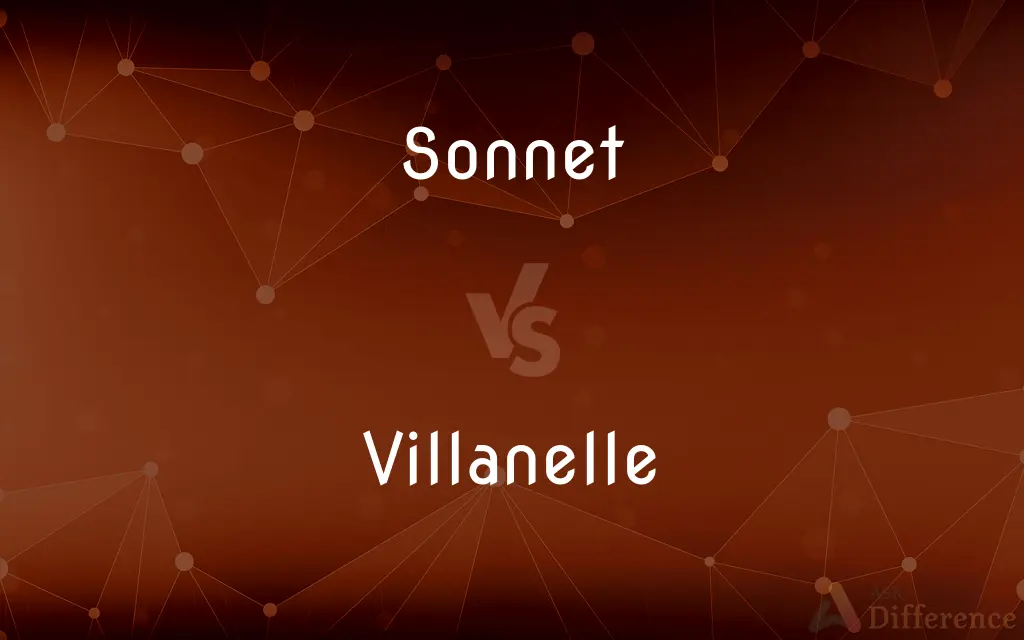Sonnet vs. Villanelle — What's the Difference?
By Tayyaba Rehman & Urooj Arif — Updated on March 27, 2024
A sonnet is a 14-line poem with a specific rhyme scheme, while a villanelle consists of 19 lines divided into five tercets and a concluding quatrain, known for its repeating refrain lines.

Difference Between Sonnet and Villanelle
Table of Contents
ADVERTISEMENT
Key Differences
The sonnet, with its 14 lines typically structured in iambic pentameter, is a poetic form that originated in Italy. It has various types, including the Petrarchan (or Italian) and Shakespearean (or English) sonnets, each with its distinctive rhyme scheme and thematic division. In contrast, the villanelle has a more rigid structure of 19 lines: five tercets (three-line stanzas) followed by a quatrain (four-line stanza). It is characterized by two repeating rhymes and two refrains, with the first and third lines of the opening tercet recurring alternately at the end of each subsequent tercet and both appearing in the final quatrain.
While sonnets offer flexibility within their structure for the poet to craft a nuanced argument or narrative arc, concluding with a philosophical or emotional revelation, villanelles focus on the power of repetition to evoke deep emotional states, creating a mesmerizing and sometimes haunting effect. The iterative nature of the villanelle makes it uniquely suited to themes of fixation and circularity, contrasting with the sonnet's potential for narrative progression and resolution.
Both forms require a high degree of precision and creativity from the poet, but they serve different artistic ends: the sonnet, with its emphasis on argumentative structure and resolution, and the villanelle, with its focus on the musical quality of language and the impact of repetition. Thus, while both forms are celebrated for their beauty and depth, they offer distinct avenues for poetic exploration.
Comparison Chart
Line Count
14 lines
19 lines
Structure
Typically in iambic pentameter
Consists of five tercets and a concluding quatrain
ADVERTISEMENT
Rhyme Scheme
Varies (e.g., ABABCDCDEFEFGG for Shakespearean)
ABA ABA ABA ABA ABA ABAA
Refrains
None
First and third lines of the first tercet are repeated
Themes
Love, nature, existential queries
Obsession, love, melancholy
Origin
Italy
France
Flexibility in Theme
High; can explore a wide range of subjects
More focused due to repetitive structure
Emotional Expression
Intellectual depth and emotional nuance
Intense emotional states, fixation
Compare with Definitions
Sonnet
Explores a wide range of themes within a compact form.
Wordsworth’s sonnets delve into nature and the human psyche.
Villanelle
A 19-line poem with two repeating rhymes and refrains.
Dylan Thomas’ Do not go gentle into that good night is a famous villanelle.
Sonnet
A 14-line poem with a specific structure and rhyme scheme.
Shakespeare's sonnets are renowned for their exploration of love and beauty.
Villanelle
Focuses on the musicality of language.
The form’s repetition and rhyme scheme contribute to its haunting, melodic effect.
Sonnet
Variants include Petrarchan and Shakespearean.
Petrarchan sonnets feature an octave and sestet with a thematic shift.
Villanelle
Characterized by its strict repetitive structure.
The repeating lines of a villanelle can underscore the poem’s central theme.
Sonnet
Often concludes with a philosophical or thematic turn.
The final couplet of a Shakespearean sonnet typically offers a resolution or twist.
Villanelle
Requires creative use of repetition.
The refrains in a villanelle are woven into the poem to enhance its lyrical quality.
Sonnet
Emphasizes argumentative and narrative progression.
Sonnets often build towards a climactic insight or revelation.
Villanelle
Suited to themes of obsession and circularity.
Villanelles often explore unending love or the inescapability of fate.
Sonnet
A sonnet is a poetic form which originated in the Italian poetry composed at the Court of the Holy Roman Emperor Frederick II in Palermo, Sicily. The 13th-century poet and notary Giacomo da Lentini is credited with the sonnet's invention for expressing courtly love.
Villanelle
A 19-line poem of fixed form consisting of five tercets and a final quatrain on two rhymes, with the first and third lines of the first tercet repeated alternately as a refrain closing the succeeding stanzas and joined as the final couplet of the quatrain.
Sonnet
A 14-line verse form often in iambic pentameter, having one of several conventional rhyme schemes and usually featuring a shift in mood or tone after the eighth or twelfth line.
Villanelle
(poetry) A type of poem, consisting of five tercets and one quatrain, with only two rhymes.
Sonnet
A poem in this form.
Villanelle
A villanelle, also known as villanesque, is a nineteen-line poetic form consisting of five tercets followed by a quatrain. There are two refrains and two repeating rhymes, with the first and third line of the first tercet repeated alternately at the end of each subsequent stanza until the last stanza, which includes both repeated lines.
Sonnet
A fixed verse form of Italian origin consisting of fourteen lines that are typically five-foot iambics and rhyme according to one of a few prescribed schemes.
Villanelle
A poem written in tercets with but two rhymes, the first and third verse of the first stanza alternating as the third verse in each successive stanza and forming a couplet at the close.
Sonnet
(intransitive) To compose sonnets.
Sonnet
(transitive) To celebrate in sonnets; to write a sonnet about.
Sonnet
A short poem, - usually amatory.
He had a wonderful desire to chant a sonnet or hymn unto Apollo Pythius.
Sonnet
A poem of fourteen lines, - two stanzas, called the octave, being of four verses each, and two stanzas, called the sestet, of three verses each, the rhymes being adjusted by a particular rule.
Sonnet
To compose sonnets.
Sonnet
A verse form consisting of 14 lines with a fixed rhyme scheme
Sonnet
Praise in a sonnet
Sonnet
Compose a sonnet
Common Curiosities
What defines a sonnet?
A sonnet is defined by its 14-line structure, specific rhyme schemes, and a thematic turn, often exploring a wide range of subjects.
Why is the sonnet considered versatile?
The sonnet is versatile due to its capacity for nuanced argumentation and exploration of diverse themes within a compact form.
What makes a villanelle unique?
The villanelle's uniqueness lies in its 19-line structure with two refrains and two repeating rhymes, emphasizing the power of repetition.
Can the themes of sonnets and villanelles overlap?
Yes, themes like love and nature can appear in both forms, but their treatment and expression will differ due to the structural constraints.
What skills are required to write sonnets and villanelles?
Writing these forms requires a mastery of language, a deep understanding of rhyme and meter, and the ability to convey complex themes within structural constraints.
Can a sonnet or a villanelle have variations in their structure?
While variations exist (e.g., Spenserian sonnet), strict adherence to form is typically what defines and distinguishes these poetic types.
How does the structure of a villanelle affect its themes?
The villanelle's repetitive structure intensifies the expression of themes, making it particularly suited to conveying obsession, love, or melancholy.
How do poets decide between writing a sonnet or a villanelle?
The choice often depends on the poet’s thematic and expressive goals, with the sonnet allowing for argumentative development and the villanelle emphasizing repetition and musicality.
Are there modern examples of sonnets and villanelles?
Both forms are alive in contemporary poetry, adapted by modern poets to explore current themes while adhering to or creatively interpreting traditional structures.
How do sonnets and villanelles influence the reader’s experience?
Sonnets engage readers with their logical progression and insightful conclusions, while villanelles create a lyrical, sometimes hypnotic, experience through repetition.
Share Your Discovery

Previous Comparison
Hostel vs. Inn
Next Comparison
Rat vs. ChipmunkAuthor Spotlight
Written by
Tayyaba RehmanTayyaba Rehman is a distinguished writer, currently serving as a primary contributor to askdifference.com. As a researcher in semantics and etymology, Tayyaba's passion for the complexity of languages and their distinctions has found a perfect home on the platform. Tayyaba delves into the intricacies of language, distinguishing between commonly confused words and phrases, thereby providing clarity for readers worldwide.
Co-written by
Urooj ArifUrooj is a skilled content writer at Ask Difference, known for her exceptional ability to simplify complex topics into engaging and informative content. With a passion for research and a flair for clear, concise writing, she consistently delivers articles that resonate with our diverse audience.
















































